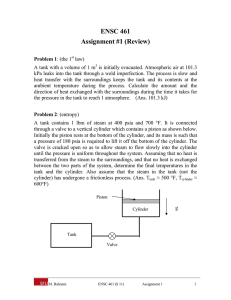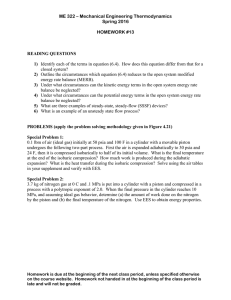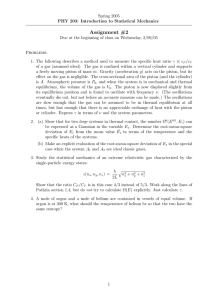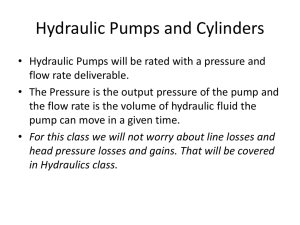Manual - Northern Tool + Equipment
advertisement
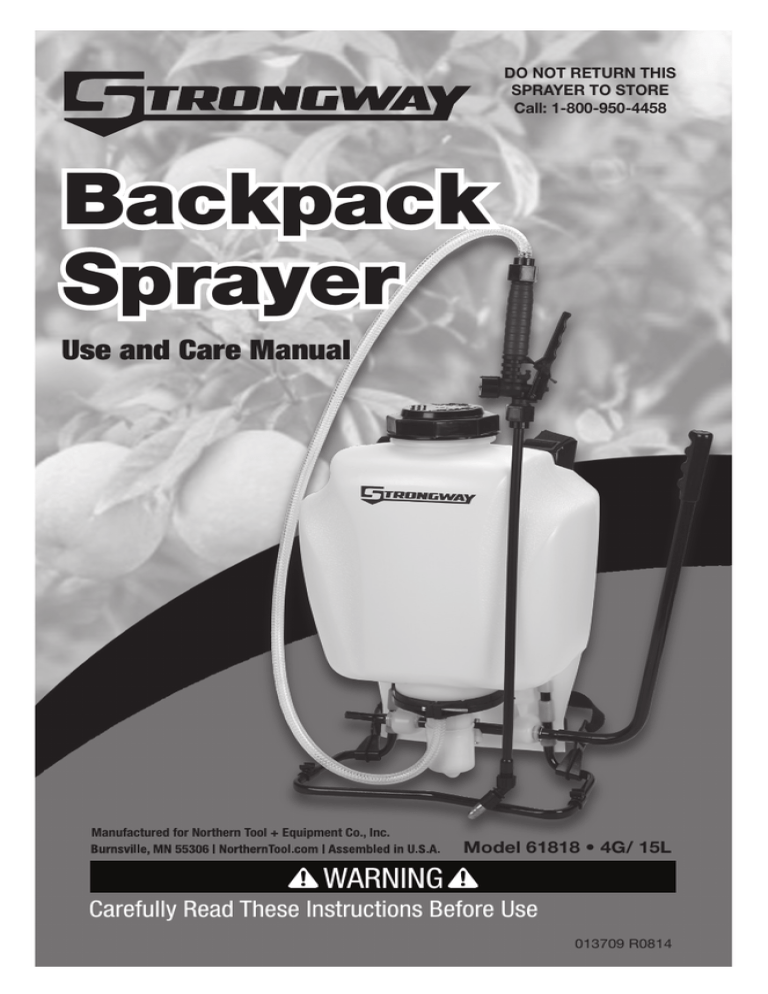
DO NOT RETURN THIS SPRAYER TO STORE Call: 1-800-950-4458 Backpack Sprayer Use and Care Manual Manufactured for Northern Tool + Equipment Co., Inc. Model 61818 • 4G/ 15L WARNING Carefully Read These Instructions Before Use 013709 R0814 WARNING WARNING: Improper use or failure to follow instructions can result in explosive failure causing serious eye or other injury. For safe use of this product you must read and follow all instructions. Do not leave a pressurized sprayer in the hot sun. Heat can cause pressure build-up resulting in possible explosion. Do not store or leave solution in tank after use. Always wear goggles, gloves, long sleeve shirt, long pants and full foot protection when spraying. Never use any tool to remove pump if there is pressure in the pressure chamber. Never pressurize sprayer by any means other than the original pump. Do not attempt to modify this sprayer. Replace parts only with manufacturer’s original parts. Never spray flammable, caustic, acidic, chlorine, bleach or other corrosive solutions or heat, pressure, or gas producing chemicals. Always read and follow chemical manufacturer’s instructions before use with this sprayer as some chemicals may be hazardous when used with this sprayer. SK 1158-1 WARNING: Handling the brass parts of this product will expose you to lead, a chemical known to the State of California to cause birth defects and other reproductive harm. Wash hands after handling. CAUTION • PRE-USE CHECK: Before each use check tightness of hose nut to be sure hose is securely attached to the shut-off assembly. Insure hose is securely attached to the tank by tightening hose clamp if necessary. Insure that all nozzle and wand connections are tight. Insure the large pump clamp is tight. Insure the 2 bolts used to attach the pump lever to the pump shaft are tight. • Do Not exceed a tank solution temperature of 120º F/ 49º C. NOTE: The tank and hose may have residual water in it due to quality testing performed on the sprayer. 1E APPLICATIONS & USE FOR YOUR SPRAYER Avoid using a sprayer for general cleaning purposes if plant protection or herbicide chemicals have already been used in the sprayer. If a sprayer has been used for plant protection or as an herbicide, clean the sprayer completely (see cleaning section) before using. Plant Food: Use different spray patterns for optimum foliage feeding or for fungicide and pesticide application. Herbicides: Reduce weeds and unwanted plants but avoid using the same sprayer for plant feeding or protection without thoroughly cleaning (see cleaning section) the sprayer first. General Household Use: Apply detergents, cleaning solutions, warm water (do not exceed 120°F/49°C) or nontoxic household cleaning chemicals for carpets, floors, walls, glass, counter tops and ceilings. DO NOT use sprayer that has been used with herbicides, pesticides or other toxic chemicals for household applications. General Outdoor Use: Use the sprayer for cleaning windows or with a detergent for general purpose cleaning. SPRAYER COMPONENTS & USE INFORMATION NOZZLE ASSEMBLY Figure 1-2 Unscrew the nozzle cap (1) from the nozzle body (3) with retaining nut (2) fastened tightly to the elbow (5). Unscrew the retaining nut (2). Push the nozzle body (3) with the nozzle gasket (4) out of the retaining nut (2). To reinstall the nozzle, reverse the above instructions. Figure 3 Unscrew the retaining nut from the elbow and push the fan nozzle tip and gasket out of the retaining nut. To reinstall the nozzle, reverse the above instructions. 1.Poly Nozzle Cap 1.Brass Nozzle Cap 2.Retaining Nut 2.Retaining Nut 3.Nozzle Body Retaining Nut 3.Nozzle Body 4.Nozzle Gasket Nozzle Gasket 4.Nozzle Gasket Elbow 5.Elbow 5.Elbow Figure 1 Figure 2 2E Fan Nozzle Tip Figure 3 SPRAYER COMPONENTS & USE INFORMATION, Continued WAND ASSEMBLY 1. Make sure the o-ring is installed on the end of the wand. Insert the wand into shut-off valve. 2. Turn and tighten the retaining nut clock-wise onto the shut-off valve. Retaining Nut O-ring Wand Shut-off Valve INSTALLING THE PUMP HANDLE The pump handle can be mounted on either side of the pump shaft (A). To install the pump handle place the handle (C) over the shaft (A) aligning the pump handle hole and shaft hole. Slide the bolt (B) through the aligned hole as shown in figure 1 thru 4. Tighten nut (D) to bolt. There are holes in the pump handle to allow for either left(fig.4) or right (fig.5) hand mounting. A. Pump Shaft D. Nut B. Bolt C. Pump Handle Nylon Lock Nut Threaded Bolt Figure 1 Figure 4 Tighten nut to bolt Figure 2 Figure 3 Line up holes Slide bolt through holes Figure 5 Figure 6 Left Hand Right Hand INSTALLING THE SHOULDER STRAP The top of the shoulder straps are attached to the tank. Attach the lower end of the straps by clipping the strap hooks to the metal frame between where the frame exits the tank and curves around. WAND CLIP The wand can be attached to the metal frame using the wand clips. Wand Clip 3E SPRAYER COMPONENTS & USE INFORMATION, Continued 3 STAGE FILTERING SYSTEM This backpack sprayer is equipped with a 3 stage filtering system (see figure Stage 1 (Filter basket) Figure 1 1). Stage 1 is a filter basket incorporated into the tank opening where fluid is added. Stage 2 filter is located at the inlet of the pressure cylinder. Stage 2 is a removable In-Tank filter. Stage 3 is a removable filter incorporated into the shut-off assembly. Periodic cleaning of these filters is recommended to insure consistent fluid flow through the sprayer. This will also reduce sprayer component wear. Stage 2 (Removable In-Tank Filter Pressure Cylinder The stage 3 filter is a removable filter incorporated into the inlet side of the shut-off valve (see section “disassembling and repairing the shut-off valve”) . Make sure pressure is released before detaching the hose from the shut-off. It is best to have no or minimal fluid in the pressure cylinder before removing and reinstalling the stage 3 shut-off filter as fluid can leak from the hose. Figure 2 Stage 2 (removable In-Tank filter) Stage 3 (removable Shut-off filter) Guide edge facing away from pressure cylinder Guide edge on pressure cylinder FILLING THE SPRAYER Make sure the filter basket is in place to keep debris from entering the tank. Determine the amount of mixture needed for your application. Add the proper amount of water to the tank. Add the proper amount of chemical to the tank (check the chemical label for proper ratio of chemical). Stir mixture in tank with a clean utensil (like a paint stirrer). The tank will hold the 4-gallon (15.1L) capacity plus the chemical. It is not necessary to completely fill the sprayer tank with each use. You can fill the tank with only the amount needed for each application. Always follow the chemical manufacturer’s instructions included on their product label. 4E SPRAYER COMPONENTS & USE INFORMATION, Continued HELPFUL SPRAYING INFORMATION Use RAPID pump strokes to prime the pump. You will know the pressure chamber is filling with liquid when you feel firm resistance from the pump. The air in the pressure chamber is compressed from repeated strokes. By pressing the hand lever on the shut-off, the valve opens. For safety lock-off feature (no-spraying), pull up on handle and move red locking mechanism into lock-off position as shown in fig. 1. To disengage, pull up on handle and return red locking mechanism to neutral position as in fig. 3. For lock-on feature (continuous spraying), push down on handle and move red locking mechanism into lockon position as shown in fig. 2. To disengage, push down on handle and return red locking mechanism to neutral position as shown in fig. 3. LOCK-OFF POSITION Locking Mechanism LOCK-ON POSITION NEUTRAL POSITION Handle Down Handle Up Figure 1 Figure 2 Figure 3 For easy pump action use the END of the pump handle. The amount of liquid delivered during spraying depends on the rate of pump stroke. The fan nozzle tip is rated at .4 gpm at 40psi. This is the nominal operating pressure of the sprayer. Note: If you experience a rapid drop in pressure, drain the sprayer completely and pump the handle with an empty tank. The pressure chamber will fill with the required volume of air to repressurize. Perform this procedure from time to time as routine maintenance. POWDER-BASED CHEMICALS Powder-based chemicals (powder mixed with liquids to make the spraying agent) are usually abrasive and can cause wear. When you use a powder-based chemical in your sprayer, make sure it is thoroughly dissolved in the liquid solution. Thoroughly clean and flush the sprayer with water to extend the life of the sprayers parts. CLEANING 1) Always empty the sprayer and clean the tank thoroughly after each use. 2) Pump the sprayer handle until all of the contents and air exit through the nozzle (minimum of 30 strokes). 3) Fill tank half way with water and pump the water out as explained in step 2 (repeat several times as necessary). Other Cleaning Hints: • Improper spray distribution usually means the nozzle is clogged, remove the nozzle and clean it. • Soap can be added to the water to clean the tank. • Do not use strong cleaning agents or abrasives. • If you use a chemical agent to clean the tank follow the manufacturer’s recommendations for the disposal of the waste water. • Follow the chemical manufacturers instructions for clean up. 5E STORING / MAINTAINING YOUR SPRAYER • The sprayer should be stored out of direct sunlight in a cool dry space. • Before freezing weather make sure to drain all liquid in the tank, pump, pressure cylinder, hose, shut-off valve, wand and nozzle, to avoid liquid expansion and cracking in the sprayer components (See “Cleaning” section). Lock the shut-off valve in the “open” position. • When service is required call your nearest NTE dealer and always insist on original manufactured replacement parts. • Inspect the hose, wand, pump, tank and shut-off valve for wear, damage or leaks on a regular basis and repair defects promptly. TROUBLE SHOOTING YOUR SPRAYER Symptom Possible Reason Correction Difficulty actuating the pump lever and/or pump handle moves itself back up. Upper valve plate sticks Piston cylinder outlet passage clogged Clean or replace valve plate Clean piston cylinder outlet passage Little or no resistance during Damaged/worn/dirty/upper and or lower valve plate repeated pumping – no pressure. Damaged /worn upper o-ring on piston Piston Collar or piston cylinder assembly is worn Too much resistance after just a few Not enough air cushion in the pressure pumping strokes but pressure only lasts chamber briefly. Upper valve plate damaged/worn/dirty Upward pumping action is more difficult Vent hole is clogged and/or pump handle moves itself Lower valve plate sticks backdown. Clogged filter Piston cylinder intake clogged Clean or Replace Valve Plate Replace O-ring Replace Collar or Piston cylinder assembly When the handle is pulled up it moves itself back down Valve Plate sticking Clean or replace valve plate Leaks at Piston Cylinder Damaged/worn/Dirty Collar Damaged Piston Cylinder Damaged Piston Clean or Replace Piston Collar Replace Piston Cylinder Replace Piston Shut-off leaks Connections loose Worn or damaged shut-off Tighten connection Rebuild or replace the shut-off valve Wand assembly leaks Connections loose Damaged or worn o-ring/gasket Tighten connection Replace o-ring/gasket Nozzle assembly leaks Connections loose Damaged or worn o-ring/gasket Tighten connection Replace o-ring/gasket Leak between pump assembly and tank Pump clamp loose O-ring worn or damaged Tighten clamp Replace pressure chamber o-ring Hose leaking at tank outlet Hose clamp loose Tighten clamp Hose leaking at shut-off Connection loose Damaged or worn o-ring/gasket Tighten retaining nut Replace o-ring/gasket 6E Release pressure in pressure chamber Remove the hose & drain pressure chamber. Reconnect the hose. Clean or replace upper valve plate Clear the vent hole in cap Clean or replace the valve plate Clean in tank filter Clean piston cylinder intake DISASSEMBLING AND REPAIRING THE PISTON PUMP C B A Figure 1 1) Remove the cotter pin and pump handle. With the pump facing towards you lay the unit on its back (Figure 1). Loosen the hose clamp and remove the sprayer hose. Caution: There could be residual liquid in the hose and pressure cylinder. Remove the nut and bolt from the protective cap and remove the cap (ref: figure 9). Rotate the pump shaft in order to reach two lever bolts(A). Using an allen wrench, remove the lever bolts. Pull the piston assembly (B) out of the piston cylinder (C). 2) Remove the piston cylinder assembly by turning the piston cylinder counter-clockwise when viewing the sprayer from the bottom. Caution: The piston cylinder may have sharp edges. Figure 2 3) Check for vertical scratches on the inside of the piston cylinder and the piston. If one or both are scratched replace them. Figure 3 Collar 4) To replace the collar, push it off of the crown of the piston with your thumb. You will see form fitted slots to install the new collar on to the piston crown. Figure 4 Piston Cylinder Intake Upper Valve Plate Lower Valve Plate Outlet Passage 5) There are 2 valve plates on the piston cylinder, one on the inside of the cylinder and one on the outside top. The valve plates are held in place with a screw and washer and can be removed and replaced using a Phillipshead screw driver. The 2 o-rings can be removed and replaced as well. Insure that the o-rings are positioned in the o-ring grooves in the piston cylinder. Figure 5 Pressure cylinder base rib Piston cylinder tab 6) Grease the 2 O-rings on the piston cylinder (do not get any grease on the valve plate) and screw the piston assembly into the pressure cylinder base. Screw the piston cylinder clockwise until tight and the bottom O-ring is no longer visible. When properly placed, the tab on the piston cylinder will line up with the rib on the pressure cylinder base. Figure 6 7E 7) Apply Petroleum jelly to the inside of the piston cylinder wall and on the collar, and reinstall the piston assembly into the piston cylinder. Figure 7 8) Insert the piston at an angle with the leading edge of the collar placed over the slot in the piston cylinder. Bolt the piston assembly to the pump shaft using the lever bolts. Figure 8 Protective Dust Cap 9) Replace the protective dust cap. Tighten the nut and bolt. Reinstall the pump handle. Replace the hose and firmly secure the hose clamp in place. Figure 9 DISASSEMBLING AND REPAIRING THE PUMP ASSEMBLY 1. Release the pressure from the sprayer and remove all liquid from both the pressure chamber and tank. 2. Remove hose. 3. Remove the In-tank filter from the pressure chamber. 4. Remove 2 bolts attaching the pivot lever to the pump shaft and remove piston assembly (fig. 2a & 2b). 5. Remove the large clamp holding the pressure chamber and tank together (fig 1). 6. Rock the pressure chamber back and forth and push down to free it from the tank (fig 1). 7. Once freed the entire pump assembly can be removed by maneuvering it through the base frame (fig 3a & 3b). Pressure Chamber o-ring Clamp In-Tank Filter Figure 1 Figure 2a Pump Assembly Figure 2b Figure 3a 8E Figure 3b Tank tab Pump Assembly Notch Figure 4 8. The pressure chamber o-ring can also be replaced. DO NOT stretch the o-ring over the bottom flange. Assemble the o-ring over the top of the chamber. Apply petroleum jelly to the o-ring before reinstalling pump asembly into the tank (fig. 3b). 9. Reassemble backwards from step 6 thru 2, performing each step in reverse. Note: there is a notch/tab combination in the pump assembly/tank to be used for alignment (fig. 4). DISASSEMBLING AND REPAIRING THE SHUT OFF VALVE 1) Assembled shut-off valve (Figure 1). Figure 1 2) Remove the retaining pin (A) (Figure 2) place the notched end of the retaining pin on a hard surface and push down. Remove the retaining pin and slide the handle off the valve. A Figure 2 Valve Stem B C 3) Remove the retaining nut (o-ring attached), spring, and valve stem (B) (Figure 3). Replace worn parts. Lubricate the O-rings and reassemble by reversing the steps above. Place the handle groove in the slotted area of the valve stem and make sure the locking clip is positioned in the neutral position (see “Helpful Spraying Information” section). Insert the retaining pin. Push down on the handle a few times to distribute the lubricant evenly. Check filter (C) in end of shut-off valve for debris. Remove filter and flush with water to clean out. Figure 3 9E REPLACEMENT PARTS ORDER INFORMATION 6-8122 Brass Adjustable Nozzle 6-8096 Flat Fan Nozzle 6-8093 Poly Adjustable Nozzle Retaining Nut 6-8169 Filter Replacement Kit 6-8148 Nozzle Kit Nozzle gasket 6-8183 Diaphragm Pump assembly w/ lever Elbow with o-ring O-ring Wand Screw Cap 6-8101 Wand Assembly Hose Washer 6-8105 Hose Assembly Retaining Nut Hose 6-8120B Shut-off Valve Repair Kit 6-8138 Shut-off Assembly 10E REPLACEMENT PARTS ORDER INFORMATION Upper Plate Valve Upper O-ring 6-8180 Piston Pump Repair Kit Lower O-ring 6-8178 Piston Cylinder Assembly CollarPump Piston O-ringPressure Cylinder Valve PlatePiston Cylinder Piston Collar 6-8179 Pump Piston Assembly O-ringPiston Cylinder Elbow O-ring Nozzle Gasket Hose Gasket 6-8153 O-ring Kit 6-8146 Filter Basket & Cap Wand O-ring 6-8152 Wand Clips 6-8137 Straps Congratulations! You have just purchased a quality Northern Tool & Equipment product. Questions? Do Not Return To Store. Call us @ 1-800-950-4458 Manufactured for Northern Tool + Equipment Co., Inc. Due to our ongoing product improvement process, product specifications may change without notice. U.S. and foreign patents pending.

